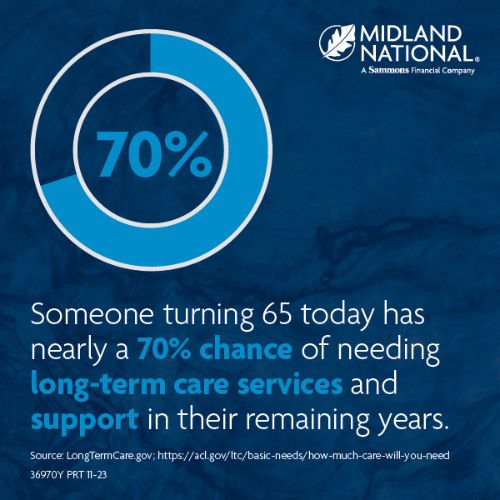
Rethinking how to pay for long-term care services
Feb 24, 2025, 3:55:03 PM | Reading Time: 3 minutesWhen planning for the future, there are many factors to consider — from where you’ll be retiring to how you wish to spend your days. Some of these things you can plan with certainty, while others may be harder to predict; this is especially true regarding your health. Someone turning 65 today has nearly a 70% chance of needing long-term care services and support in their remaining years. Long-term care insurance is a common option that can help pay for senior care, but there are often limitations on what is covered and may not apply to your specific situation. Considering alternatives that can supplement your financial plan can help fill in any gaps and ensure you or your spouse are covered in the future.

What does long-term care insurance cover?
Long-term care insurance covers costs associated with chronic medical conditions and age-related impairments not covered under typical health insurance. These policies typically pay or reimburse for long-term care costs and include care you receive in your home, nursing home, adult day care service center, or assisted living facility. Many long-term care insurance policies limit how long or how much they will pay, and they may not cover pre-existing conditions like Parkinson’s disease, Alzheimer’s disease, or certain forms of cancer.
Does Medicare cover long-term care costs?
Most health insurance, Medicare, and Medigap plans do not pay for long-term care. If you need skilled nursing care or therapy services, Medicare may cover the cost of a home health aide and doctor services, hospital care, and medical supplies while in the nursing home.
Paying for nursing homes and senior care without long-term care insurance
To help pay for long-term care, there are additional options to consider, including annuities and life insurance Here are ways that adding annuities and life insurance to your comprehensive financial plan can help you save money for senior care expenses.
Annuities for long-term care costs
To help bring more financial security and predictability to your retirement, purchasing an annuity can provide a guaranteed income stream for the future. Either through one lump-sum payment or several payments, you can purchase an annuity that has the potential to grow your savings and provide income payments either immediately or years down the road. In the case of providing access to your money for long-term care costs, a deferred annuity is likely a good match since many immediate annuities have limited liquidity.

Along with providing income for retirement, some types of annuities offer an annual penalty-free withdrawal amount that you can take out without incurring a surrender charge. Other types have specific features that can trigger additional liquidity options if certain conditions are met, like an extended nursing home stay or the loss of ability to complete certain activities of daily living. If you never require long-term care, you can use that income from your annuity for other needs and create retirement savings you can count on — helping protect yourself from outliving your money.
Life insurance with long-term care benefits
Many life insurance policies go beyond offering a death benefit and can also provide additional options including long term care riders or living benefits. With living benefits, you may be able to access a portion of your policy’s death benefit while alive if you’re diagnosed with a qualifying illness. So, in addition to having valuable financial protection for your loved ones, you may also have funds available to help with long-term care costs if needed.
The cost of long-term care can vary from state to state. Still, the expenses can add up quickly, especially since national median costs associated with long-term care service providers continue to increase. Including solutions in your overall financial plan to address these senior care costs can help you be better prepared and prevent you from quickly draining your retirement savings if a health event occurs. Consider meeting with a financial professional to discuss your goals, concerns and how you can better plan for future health expenses and long-term care costs while keeping your retirement on track.
B4-MN-11-23
